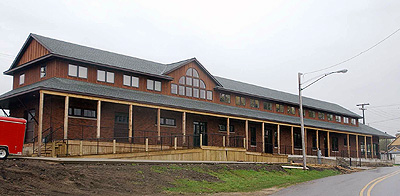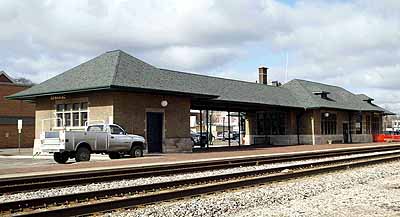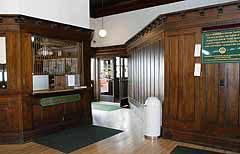This report was prepared for the Michigan Department of Transportation
by the Seidman College of Business Grand Valley State University.
Executive Summary
Passenger rail service is perceived to provide important benefits to Michigan communities. The extent of these benefits has never been quantified in a systematic way and, in 2008, the Michigan Department of Transportation (MDOT) contracted with Grand Valley State University to perform a broad based assessment of the community level benefits of passenger rail service.
The main objective of the research project has been to estimate the full range of these benefits at the community level. It is understood that passenger rail services provide important additional benefits to the state and the region in terms of congestion relief, safety, air quality improvement, and energy conservation. These benefits are discussed in the report but statewide or regional benefits are not quantified.
The research included a literature survey of other related studies to assess methodological implications for this project. Conclusions derived were that: benefits are sensitive to ridership activity (which is in turn influenced by service offerings); regional economic data should be used where possible; benefits of foregone travel should be estimated; long term benefits are contingent on local and regional development plans; and, projected benefits represent only estimates at a point in time subject to changing demographics, the economic profiles of different regions and the cost structure of competing forms of transportation.
It is important to recognize that Michigan communities receive only low or medium frequency levels of passenger rail service. Eleven of Michigan’s 22 station communities have only a single daily round trip while the other half have from two to four daily round trips. These levels of service should not be expected to generate the kinds of economic impacts experienced by communities served by commuter rail, light rail, or heavy rail systems with hourly or more frequent service throughout the day. That said, existing Amtrak services to Michigan communities have been found to generate significant benefits and these benefits can be meaningfully quantified.
The National Railroad Passenger Corporation, operating under the Amtrak name, has since 1971, been the sole provider of intercity passenger rail service in Michigan. These services are provided to Michigan stations located on three corridors…
- The Wolverine Corridor between Pontiac, Detroit and Chicago
- The Blue Water Corridor between Port Huron and Chicago
- The Pere Marquette Corridor between Grand Rapids and Chicago.
Ridership on these services has grown by over 50% thus far this decade—from 457,000 passengers in the year 2000 to 724,000 passengers in 2008.
The 22 stations vary greatly in terms of ownership, age, architecture, staffing, and operation. They range from simple bus stop type shelters to historic restored depots to relatively modern buildings. Only ten of the stations are staffed with Amtrak station agents. Passengers boarding at other locations must purchase their ticket from a ticket machine, travel agent, Amtrak’s web site, or from the conductor on the train. Thirteen of the stations are city owned, five are Amtrak owned, one each are owned by a local transit agency, Michigan State University, MDOT and a private owner. Operating responsibilities lie with cities, transit agencies, Amtrak, civic organizations or a mix of any of these organizations. There is no common model.
The principal objective of this research was to determine the benefits of passenger rail service to a local community. As such, a unique “Community Benefits Summary Sheet” was prepared for each station community. This Excel spreadsheet approach utilized information from MDOT’s Transportation Management System (TMS). The spreadsheet is easily updatable and could possibly be directly integrated with the TMS system. Benefits may be classified into the following categories:
a. Individual traveler benefits. Passenger trains offer an economical mode of transportation that is usually less expensive than flying or driving. This task compared existing passenger rail costs to costs that would be incurred if there were no passenger rail service in a community and alternative modes were used (or, alternately the trip was foregone). Ridership information was first obtained for each station from MDOT’s Transportation Management System. The second step was to determine whether these travelers would make the trip in the absence of Amtrak service, and, if so, what mode would they use (auto, bus or plane). The 2007 MDOT/University of Michigan on-board survey was used for this purpose. The third step was to determine the costs of alternative mode travel. This was done primarily by internet searches of bus and airline fares assuming a 14-day advance purchase of a round trip ticket on a non-peak travel day. Costs for auto drivers was assumed to be the first half of 2008, IRS rate of $.505 per mile divided by auto occupancy of about 1.8 persons (occupancy levels varied somewhat from corridor to corridor). This information was compiled for all major travel pairs for each station. Total statewide traveler savings were calculated as $20.0 million for those individuals who used Amtrak instead of other modes of transportation. An estimate of the economic benefit of Amtrak service for passengers who would not make the trip in the absence of Amtrak service was calculated at $2.7 million.
b. Local business benefits. Travelers may utilize the train to travel to or from a community where they may use a taxi, rent a car, stay at a hotel, and eat at a restaurant. They may attend a conference or a sports event and they may shop in the community. This may vary from community to community but these and similar expenditures send a stream of benefits to many parts of the area. On-board survey data was used to determine the percentage of travelers that used taxis, rental cars, or local transit to access the train. Information was also obtained on passengers using hotels as well as length of stay. Respondents also indicated a primary trip purpose such as business or shopping. These responses allowed the research team to develop estimates, for example, of the number of persons who used taxis, stayed at hotels and shopped in station communities. The team was careful to isolate persons spending money in Michigan as opposed to Chicago or other out-of-state locations. Since Chicago is an important destination for Michigan train travelers it was important to exclude certain costs for travelers who resided in Michigan and were going to Chicago. As such, a conservative approach was utilized that considered Michigan hotel stays, meals, shopping and other activities for only non-Michigan residents. These types of direct expenditures send a stream of benefits throughout the community and were subject to an economic multiplier that resulted in local community benefits of $25.7 million.
c. Amtrak Expenditures. Amtrak operates all of the passenger rail services in Michigan. As such, Amtrak expends considerable amounts of money in Michigan for employee wages, supplies, and stations. In 2008, Amtrak employed 115 persons in Michigan. There are 48 persons involved in train operations as engineers, conductors, or train maintenance workers. There are 27 persons involved with station services including selling tickets. There are 40 employees involved in track and signal maintenance jobs related to the Amtrak owned track between Kalamazoo and Porter, Indiana. These employees were assigned to individual stations based on their work assignments. Other costs such as hotel, meal, and taxi costs for crew layovers in Michigan were also calculated by station, as were estimates for fuel and other supplies purchased in Michigan for use on Michigan services. As might be expected Amtrak expenditures are heavily weighted towards those station communities that serve as a crew base for Amtrak employees. Pontiac and Niles are good examples of stations with modest ridership but high levels of Amtrak expenditures. Costs for Amtrak vendor procurements that were not directly related to Michigan train operations were not included (e.g., purchase of over $1 million in shoes from a Michigan vendor). Direct and indirect expenditures associated with Amtrak service in Michigan amounted to $13.6 million.
The 22 Michigan communities with Amtrak stations receive $62 million annually in quantifiable benefits attributable to passenger rail service. These benefits are summarized below for each of the three corridors. It is important to state that these represent quantifiable benefits attributable only to the local communities. Additional benefits more difficult to quantify relate to how the existence of passenger rail service in a community enhances its image as a place to live and do business. Significant additional benefits also accrue to the region and the state related to traffic congestion relief, safety, energy conservation, and air quality improvement. These benefits are substantial and research for the American Public Transportation Association (APTA) indicates that safety and vehicle emission costs alone amounted to $.07 per vehicle mile in 1999. It is important to emphasize that these and other macro level benefits must be included in any consideration of the overall value of Amtrak service.
Summary of Quantifiable Community Benefits
| |
Pere Marquette Corridor |
Blue Water Corridor |
Wolverine Corridor |
Total Statewide |
| Traveler savings |
$2,808,380 |
$4,283,972 |
$12,872,105 |
$19,964,456 |
| Non-traveler savings |
$ 345,737 |
$ 545,449 |
$ 1,848,575 |
$ 2,739,761 |
| Local business benefits |
$3,572,199 |
$2,942,865 |
$19,159,480 |
$25,674,544 |
| Amtrak expenditures |
$ 551,035 |
$1,949,089 |
$11,133,556 |
$13,633,680 |
| Total community benefits |
$7,277,351 |
$9,721,374 |
$45,013,716 |
$62,012,441 |
Telephone interviews of community leaders and field surveys of each station were conducted as part of the work effort. This enabled the research team to obtain information and determine perceived and actual benefits associated with having an Amtrak station in a community. In general, there was a high degree of community support for the stations. The importance of the station to the community varies depending on the size and nature of the community and the type of station. In the smaller communities, the station may serve as a focal point for local activities and may even provide meeting space for public events or house the offices of the local chamber of commerce. In many cases, the station is seen as the only public link to intercity transportation because of the lack of intercity bus service or access to air service.
In larger communities, the service is viewed as one part of the multimodal transportation system but an important asset to the community. The location of the facility determines its potential for acting as a catalyst for further community economic development. The direct impact of the station on local businesses was generally acknowledged but little hard data was available. Restaurants and bars near stations receive additional business from travelers waiting for the train or disembarking in the community. Taxis serve most stations if the community is large enough to support a taxi service.
In tourist-oriented communities, rail service provides direct access (walking) to local attractions. This is the case in St. Joseph, Dearborn (Greenfield Village platform) and New Buffalo. The survey respondents viewed passenger rail service as an important option for minority 10 and low income populations in the communities. It was also seen as an important service for college students in university communities such as East Lansing, Ann Arbor, Kalamazoo, and Albion.
A number of station communities have recently improved their stations and others are planning to do so. The report contains case studies of strategic approaches to station development by six Michigan communities. The report also contains a discussion of other community development benefits resulting from station development initiatives. This includes increased employment, increased property values and increased tax base. The concept of Transit Oriented Development (TOD) is discussed. Further, a literature review was undertaken of economic impacts associated with rail related developments. Most of the national research deals with developments in high-density urban areas where high levels of transit service are being proposed. This is quite different from the Michigan situation but does offer some insight on the strategic and developmental aspects of station development. The authors did obtain information on economic development issues relating to a proposed new commuter rail service in Wisconsin and the Amtrak “Downeaster” service from Boston to Portland. The latter service is more closely aligned with Michigan type services, but with important differences in terms of corridor length and service frequency. Economic studies of the “Downeaster” service expect significant growth in ridership and local development adjacent to the stations over the next few years.
Significant local economic benefits are associated with the provision of Amtrak service in Michigan. This research indicates local communities currently realize $62.0 million annually in benefits. Additional benefits accrue to the region, state, and nation in the form of congestion relief, air quality improvement, energy conservation, and safety. The benefits accrue to the local community even though service is very limited with only a single daily round trip provided to half of Michigan’s stations. This severely limits the potential for economic development impacts. The implementation of greatly improved levels of service and train speeds such as those in the proposed high speed Midwest Regional Rail System would dramatically change station area dynamics and overall benefit levels for local communities. The addition of commuter services in the southeast Michigan region would also result in major station development opportunities.

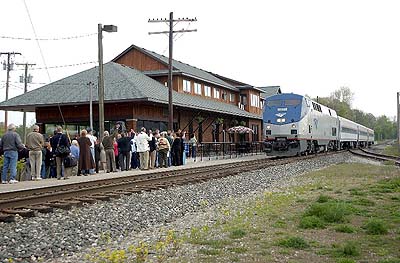
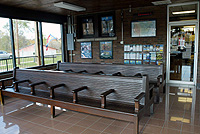 The unstaffed
The unstaffed 